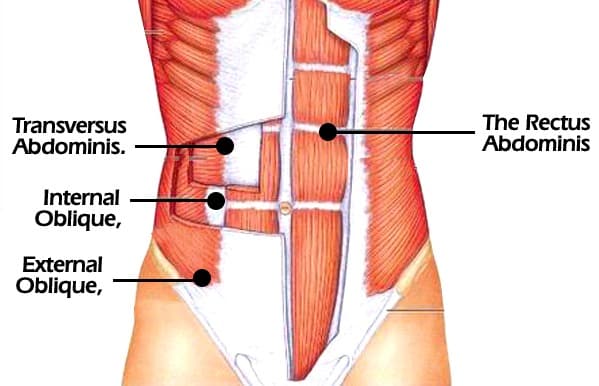The Rectus Abdominis is a paired vertical muscle that runs from the xiphoid process at the bottom of the sternum, across the top of the 5th and 7th ribs and down to the pubic symphysis, pubic crest, and pubic tubercle below the hip-line. The two muscles are separated by the linea alba running down their center, which is a connective band for the muscles. The rectus sheath holds the muscle; it is also the insertion point for the lateral abdominal muscles. The tendinous intersections cross the muscle, separating it into eight distinct squares, or bellies, the top 6 of which form the “six pack”.
The rectus abdominis is used to flex the lumbar spine, the lowest 5 vertebrae of the spine. It is also a very useful muscle for breathing; it is used during childbirth, defecation, and forceful exhales. The muscles flex in pairs, which allows for efficient recruitment when forward folding, or putting legs over your head in plow. The muscles aid in lifting the trunk and are the muscles activate in traditional crunches. Usually the first tendinous intersections cross just above the belly button and the second line crosses between the sternum and first tendinous intersections. They belly button is known as the umbilicus in anatomy nomenclature.
There is some misinformation about the rectus abdominis muscle that really should be cleared up. The first, is that working on the muscle is not what gives people definition in the six tendinous intersections called a “6 pack”. Levels of body fat are a more accurate determinant for whether a person’s abdominal region will be well-defined, or not. Usually, this starts around the 15% and lower for men, though there are always outliers and special cases. However, once you are at that level of body fat, the amount of exercise and abdominal activity present in your daily life will affect the definition of the abdominal muscles. Another myth is that regular crunches are ineffective. Regular crunches are some of the most effective activity for activating the rectus abdominis muscle alone, if they are done properly with exhalations to peak and a vertical lift of the chest rather than leaning towards the knees. In other words, the efficacy of crunches are determined by proper alignment.
I find that bicycle crunches done slowly are still the most effective abdominal workout for me. 5 minutes and I am toasted. Slow down when doing the exercises, use your breath to move your body mindfully and in unison. Some great stretches for the rectus abdominis muscle are upward facing dog, cobra, downward facing bow, and wheel.
What are your favorite ways to stretch and strengthen your abdominal muscles?

